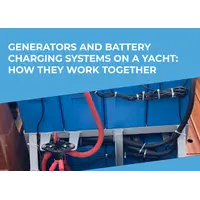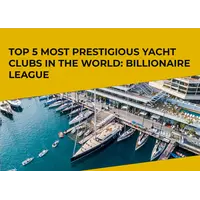If you are interested in optimization of watermaking process on board your yacht, in this article we gathered all the best practices and advices based on products that we tested at topRik and our own practical knowledge. We will discuss water efficiency in general, estimating your water needs, choosing the right watermaker, conservation strategies, operating procedures, alternative supply sources and proper disposal of waste water. Let’s begin.
Introduction
A watermaker is a purchase that can either pay off greatly or not pay off at all – it depends on your practices.
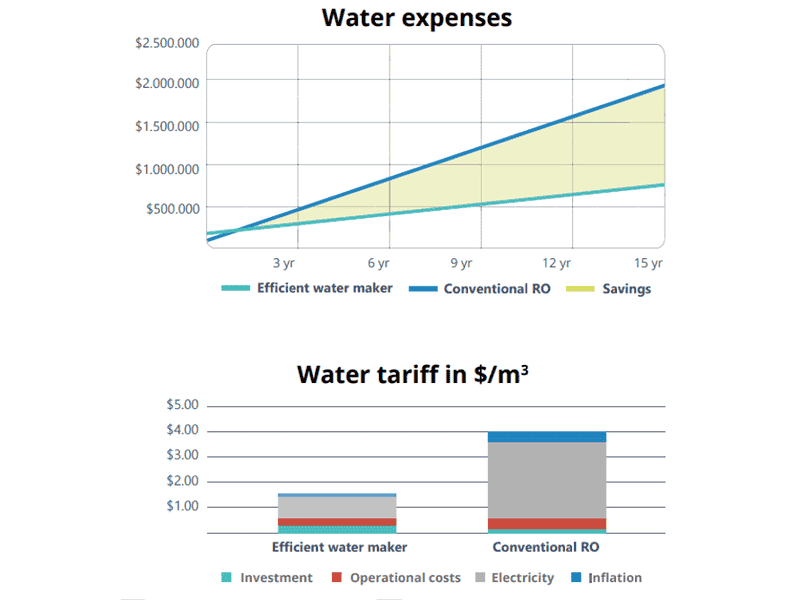
Wise management of available resources is what differentiates a great skipper from an average one, and water efficiency is one of key aspects. By implementing these strategies, you can enjoy extended voyages without compromising on comfort or sustainability.
[vitrina]1686,1631,1687,1822[/vitrina]
Importance of Water Efficiency on Yachts
High water efficiency on a yacht allows you to achieve multiple goals. Firstly, it allows you to optimize your water supply, ensuring you have an adequate amount for all onboard activities and that the passengers are not limited in terms of comfort. Secondly, water efficiency on yachts promotes self-sufficiency, as relying on shore-based water sources may not always be feasible or convenient – some marinas make great business by capitalizing on their location and selling water for whopping 25 euro a bottle.
By embracing water efficiency practices, you can enhance your cruising experience while minimizing your ecological footprint also – you will end up dumping less waste into the ocean.
Overview of How Marine Water Makers Can Improve Water Efficiency
Marine water makers are innovative devices specifically designed to produce fresh water by removing salt and impurities from seawater. They utilize advanced filtration and desalination techniques, allowing yacht owners to generate their water supply directly from the ocean. Here’s how the water flow is optimized in a modern watermaker:
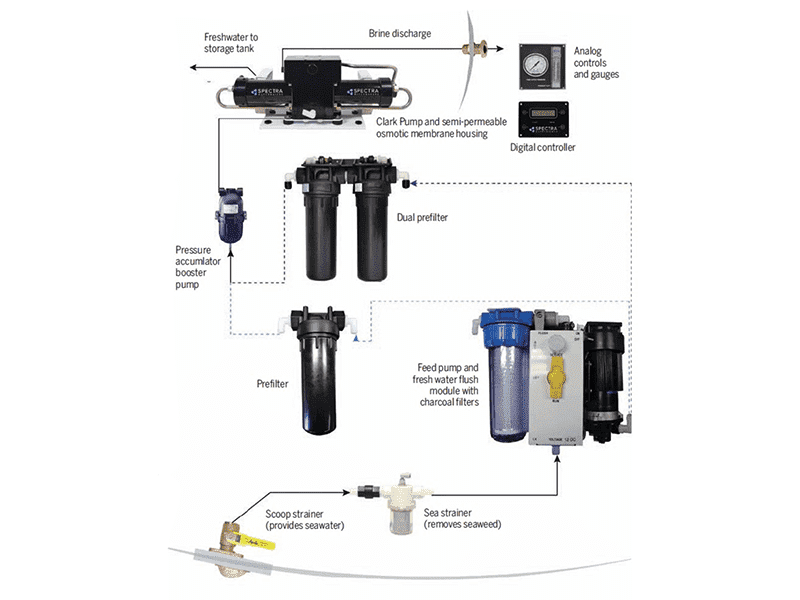
After installing a marine water maker, you can tap into an almost limitless source of water, ensuring a constant and reliable supply throughout your voyage. It is better to use it efficiently also – it will keep your watermaker operating on schedule, without big downtimes, which could lead to additional maintenance.
Assessing Water Needs
Before selecting a marine water maker, try and calculate your water needs as accurately as you can - by understanding your consumption patterns, you can determine the appropriate water maker capacity and ensure optimal efficiency. Here are two primary factors to consider.
Estimating Daily Water Usage
On average, an individual uses around 75-115 liters (20-30 gallons) every day for drinking, cooking, hygiene, and cleaning purposes – just multiply this figure by the number of people on board to figure out your estimated usage. Keep in mind that this estimation should be conservative, with some cushion included, allowing for emergencies or increased water demands.
Identifying Water-Intensive Activities
This step is crucial for managing your water supply effectively – there are some activities such as showers, dishwashing, and laundry, that can consume significant amounts of water at once.
By recognizing these water-intensive tasks, you can implement targeted conservation strategies and ensure your water maker meets the demand. For example, choosing a water maker with a higher production capacity may be necessary if you anticipate frequent laundry or have a larger crew on board.
Choosing the Right Marine Water Maker
There are a lot of desalination devices to choose from – it is always better to consult with a specialist before fully committing to the purchase. Here at topRik we are always glad to help with an advice (you can send us a message through feedback form), but here’s some information in case you like to do everything on you own.
Evaluating Water Maker Capacity
Water maker capacity refers to the volume of fresh water the device can produce within a specified period, typically measured in liters or gallons per hour – it affects both its performance and its price, so try not overpay for something you don’t actually need.
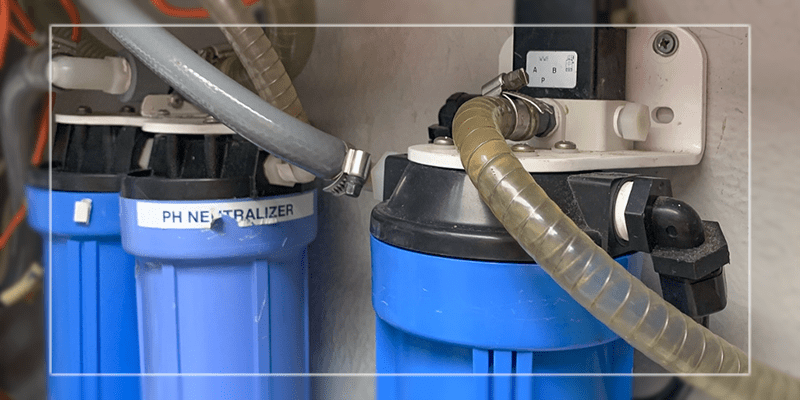
Don’t forget that a bigger watermaker also means higher electricity consumption and more expensive maintenance. Also, you better free some space on board your vessel for storing the produced water in advance.
Considering Power Requirements and Space Limitations
Marine water makers require a power source to operate effectively – pay attention to that when purchasing one. Evaluate your yacht's power generation capabilities and ensure they can accommodate the water maker's electrical demands.
You will need some space for the watermaker itself so take into account the layout of your boat too. Some models may require more significant space for installation, while others are designed for compact installations in limited areas. You can go for a modular model in case you need to spread it between different locations.
Water Conservation Strategies
In addition to investing in an appropriate marine water maker, implementing water conservation strategies can further optimize water efficiency on your yacht. Try to the follow these techniques.
Installing Low-Flow Fixtures
Low-flow fixtures, such as aerated faucets and showerheads, reduce water consumption without sacrificing comfort. These fixtures inject air into the water stream, creating the illusion of high water pressure while using less water.
By installing these fixtures, you can achieve significant water savings without compromising the onboard experience.
[vitrina]1832,1867,1820,1813,6481[/vitrina]
Collecting and Recycling Greywater
Why waste something that can be reused? Greywater refers to wastewater generated from activities like laundry, showering, dishwashing. Instead of disposing of this water, we can collect and treat it for reuse in non-potable applications, such as deck cleaning or toilet flushing. As a result, you not only conserve water but also minimize the strain on your water maker and reduce the frequency of required pump replacement, membrane flushing and other procedures.
Monitoring Water Usage and Identifying Inefficiencies
Getting a water monitoring system is a good idea to track and analyze your yacht's water consumption. Knowing what the problem is mean you can promptly address it, while minimizing water wastage and repairs time.
Monitoring your water usage patterns also enables you to make more informed decisions when it comes to optimizing your resources – you know when you have enough water on board or when it’s time to turn on the watermaker.
Proper Maintenance and Operation
Water management with a desalinator on board is not all about calculating your water needs. It is also about reading the manual, buying repair kits, replacing contaminated membranes and many other things. If the watermaker is not working properly, you can forget about any kind of efficiency.
Keeping the Water Maker in Good Condition
Regular maintenance is crucial to ensure the optimal performance and longevity of your water maker.
Always follow the manufacturer's guidelines for routine maintenance tasks such as cleaning or replacing filters, inspecting and maintaining pumps and membranes, and checking for any signs of wear or damage. In the long run, you save money by doing so, even if it doesn’t feel like it at the moment. By keeping the water maker in good condition, you can prevent malfunctions and ensure a consistent production of high-quality freshwater.
Make sure to schedule regular professional servicing in case your device got into some real trouble that you can’t fix yourself.
Following Recommended Operating Procedures
The manufacturer provides specific operating procedures for your marine water maker, which should be carefully followed, they are always provided with the product in a detailed manual. Familiarize yourself with the instructions and ensure that all crew members are aware of the correct operating procedures – you might need to delegate the maintenance if your hands are too busy.
- Introduction
- General
- Technical data
- System description
- Installation
- General criteria and material required
- Components mounting
- Water intake
- Hydraulic connections
- Electric connections
- Operating procedures
- Remote panel commands
- First start-up procedure
- Normal operations
- Maintenance
- Shutdown procedure
- Maintenance and recurrent inspections
- Troubleshooting
- Safety cautions
- Warranty
Pay attention to factors such as operating pressures, temperatures, maintenance intervals to achieve efficient operation, prevent unnecessary strain on components and reduce the risk of damage or breakdown. It is also a popular practice to keep a record of maintenance activities and set up a schedule for the crew, so everybody is on the same page.
Alternative Water Sources
In addition to marine water makers, exploring alternative water sources can enhance water efficiency on your yacht.
Collecting Rainwater
Rainwater can be a valuable source of freshwater if collected and stored properly. You’ll need to equip your device with a rainwater collection system with appropriate filters and storage tanks to capture rainwater for various non-potable uses.
Try to design the system so it effectively collects rainwater from a lot of vessel’s surfaces, such as the deck or sails, and direct it to storage tanks. However, ensure that the collected rainwater is free from pollutants and contaminants before utilizing it. Implementing regular testing and appropriate treatment methods, such as UV sterilization or filtration, can ensure the rainwater's safety for intended uses.
Using Manual Desalination Systems
Manual hand-operated desalination systems on board a yacht are compact and efficient devices designed to convert seawater into fresh drinking water. These systems are specifically designed for situations where access to freshwater sources and electricity are both limited, such as during long voyages or in remote areas.
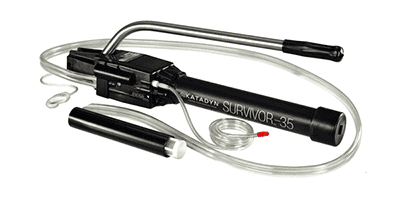
Unlike automated desalination systems that rely on electric pumps, manual hand-operated systems require physical effort from the operator to generate the necessary pressure. This is usually achieved through a hand pump or lever system. By manually operating the pump, the yacht crew or passengers can create the pressure needed to force seawater through the RO membrane, resulting in around couple of liters of fresh water an hour.
Proper Disposal of Waste Water
Responsible disposal of waste water is crucial for environmental sustainability and compliance with local regulations – recklessness in this field might lead to problems with the law or damage your reputation in the yachting community.
Disposing of Waste Water Responsibly
Waste water generated from activities such as dishwashing, showering and cleaning should be directed to appropriate holding tanks or treatment systems according to local recommended disposal methods - when in Rome, do as the Romans do. Install and maintain efficient wastewater collection systems that separate different waste streams, allowing for proper treatment and disposal. Here’s a popular boat layout fit for proper waste management:
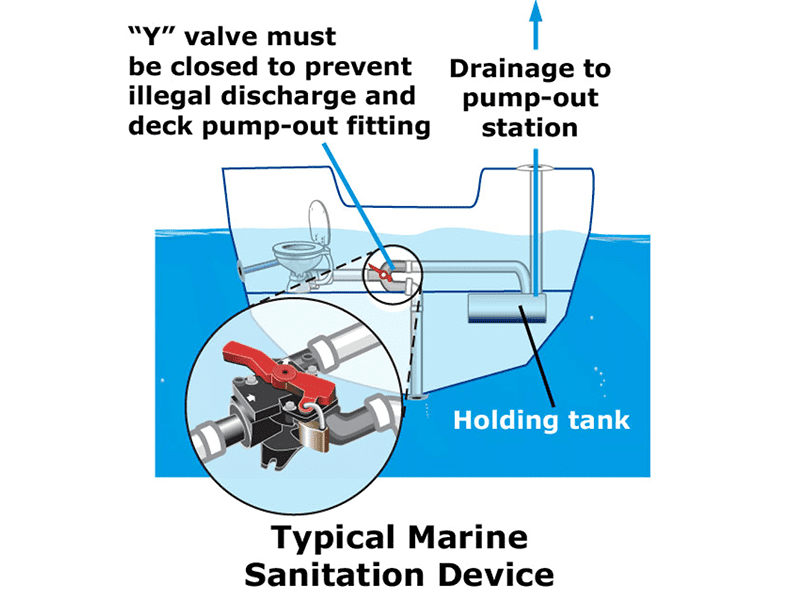
Try not to discharge waste directly into the ocean to prevent environmental contamination and maintain the integrity of marine ecosystems.
Complying with Local Regulations
Different regions have specific regulations regarding waste water disposal and treatment - familiarize yourself with these regulations and see if your yacht’s layout allows you to comply.
This includes adhering to guidelines on waste water discharge, treatment, and the use of approved waste water management systems. Qualified professionals will help you install management systems that meet or exceed local requirements, but you should regularly review and update your own practices to ensure ongoing compliance with all kind of constantly evolving regulations and laws. Here’s an example of USA’s approach to this problem (other countries might have different laws):

By properly maintaining and operating your water maker, exploring alternative water sources, and disposing of waste water responsibly you help not only to make the world a better place, but also to make your yacht a better place in this world for your passengers. The practices we covered will help you justify the watermaker purchase and optimize its usage.
If you got any other questions, feel free to send us an e-mail regarding best watermaker choice for your vessel, its installation and operation. After testing such products in practice for years, topRik experts can provide detailed advice, tailored specifically for your needs.



